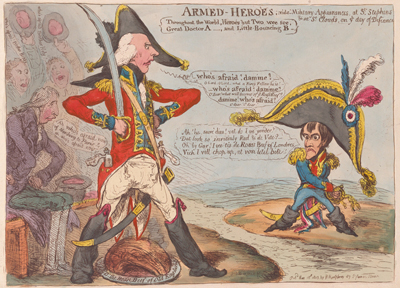Armed Heroes. . .
Armed Heroes shows Prime Minister Henry Addington dressed (uncharacteristically) as a soldier with sword drawn, straddling a roast beef (symbolic of "old England" itself) and glaring at Napoleon across the English channel. Behind him, on a Parliamentary-looking bench sits the Secretary of State for Foreign Affairs, Robert Jenkinson, Lord Hawkesbury who had helped negotiate the Treaty of Amiens which bought a temporary peace with France in March 1802. The print is dated 18 May 1803, the day that Britain officially ended the Treaty and resumed the war with France.

© Beinecke Rare Book and Manuscript Library, Yale University
In contrast to the diminutive Bonaparte who knows exactly what he wants ("Oh by Gar! I see 'tis de Roast Beef of Londres/Vich I vill chop up, at von letel bite."), Gillray portrays a deeply ambivalent Addington, uncomfortable with the role of wartime Prime Minister, alternating between bluster and fear with a "Stimulating Draft" in one pocket and a "Composing Draft" in the other.
who's afraid? damme?
O lord, O Lord what a Firey Fellow he is
who's afraid? damme?
O dear! what will become of ye Roast Beef?
His pusillanimity is, of course, further emphasized by the discrepancy in size. Addington is large and should be powerful. Buonaparte is so small as to be dwarfed by his own bicorne hat.
The subtitle of the print suggests that it represents the "Military Appearances" of the two leaders on "ye day of Defiance." The reference is to an episode at St. Stephens (i.e. Parliament) when, to the amusement of some people, Addington appeared to enter the chamber dressed in the military uniform of the Reading Volunteers. But it was soon realized that he was simply wearing the (non-military) Windsor Uniform. Although Gillray alludes to the episode in his subtitle, he shows Addington (in all the prints I have seen) in the uniform of neither the Reading Volunteers nor the Windsor dress but the more readily identifiable red of the British army in contrast to Buonaparte's blue.
Behind the Prime Minister, Hawkesbury shows a similar pattern of bravado and fear.
Ah who's afraid now of Marching to Paris?
ah who's afraid now‐
The reference in this case is to an early speech by Hawkesbury (which Gillray alludes to in other prints) when the war with France was thought to be a brief affair and Hawkesbury is said to have spoken approvingly of a British "March to Paris." The "Who's afraid" protestation is echoed by relations of Addington—Heley and Bragg— for whom the Prime Minister had conveniently obtained sinecures.
Sources and Reading
- Commentary from the British Museum on Armed Heroes. . ..
- "Henry Addington, 1st Viscount Sidmouth," Wikipedia
- "Robert Jenkinson, 2nd Earl of Liverpool," Wikipedia
- "Treaty of Amiens," Wikipedia
- "Napoleon," Wikipedia
- "Windsor Uniform," Nancy Mayer: Regency Researcher
- Thomas Wright and R.H. Evans, Historical and Descriptive Account of the Caricatures of James Gillray #276.
- Thomas Wright and Joseph Grego, The Works of James Gillray, the Caricaturist; With the History of His Life and Times, p. X.
Comments & Corrections
NOTE: Comments and/or corrections are always appreciated. To make that easier, I have included a form below that you can use. I promise never to share any of the info provided without your express permission.